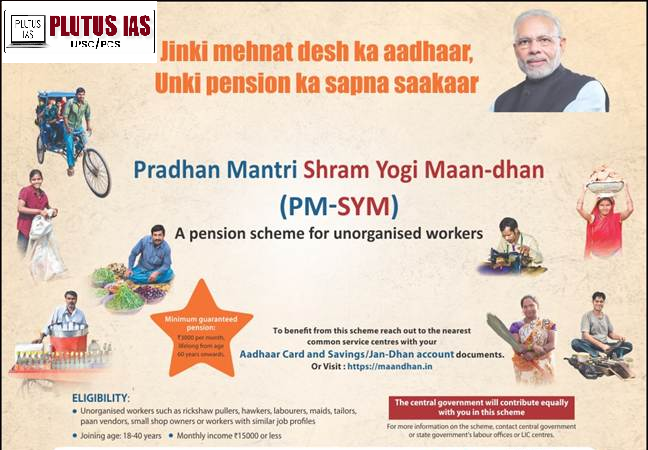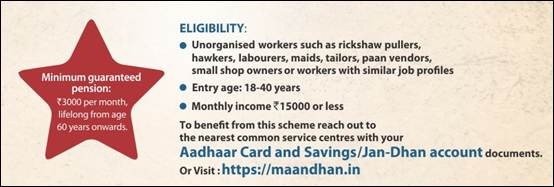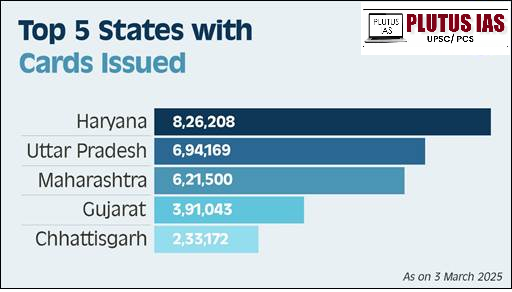12 Mar PM-SYM: Ensuring Financial Security for India’s Unorganised Workforce
This article covers “Daily Current Affairs” and Topic details. PM-SYM: Ensuring Financial Security for India’s Unorganised Workforce
SYLLABUS MAPPING:
GS-3- Indian Economy- PM-SYM: Ensuring Financial Security for India’s Unorganised Workforce
FOR PRELIMS
What is PM-SYM, key features of the E-Shram portal, and PM-SYM gov Initiatives Regarding Unorganised Sector
FOR MAINS
Significance of PM-SYM, its objective, and the issue in the Unorganised Sector and ways forward
Why in the news?
The Pradhan Mantri Shram Yogi Maandhan (PM-SYM) is a voluntary pension scheme by the Government of India providing social security to unorganised workers. It guarantees a ₹3,000 monthly pension after 60 years for workers earning up to ₹15,000 per month. Acknowledging their significant role in contributing nearly 50% of India’s GDP, the scheme covers various unorganised sector workers, including street vendors, domestic workers, construction labourers, and more. As of December 31, 2024, over 30.51 crore unorganised workers are registered on the e-Shram portal.

key features of PM-SYM
1. Minimum Assured Pension: ₹3,000 per month after 60 years of age.
2. Government Contribution: The Government of India matches the worker’s contribution on a 1:1 basis.
3. Voluntary and Contributory: The scheme is voluntary, allowing workers to contribute based on their affordability and requirements.
4. Family Pension: If the beneficiary passes away, the spouse receives 50% of the pension amount as a family pension. Family pension is applicable only to spouses.
5. Exit Provisions: Participants can exit the scheme under specified conditions (detailed in section 9).
6. Easy Enrolment: Eligible workers can register at Common Service Centres (CSCs) or through the Maandhan portal.
7. Fund Management: The scheme is administered by LIC, ensuring financial stability and credibility.

Eligibility Criteria
1. Age Requirement: 18 to 40 years.
2. Income Limit: Monthly income should be ₹15,000 or less.
3. Unorganised Sector Employment: Workers engaged in professions such as:
Street vendors, rag pickers, rickshaw pullers
Construction workers, daily wage labourers
Agricultural workers, beedi workers
Domestic workers, weavers, artisans, fishermen, leather workers, etc.
4. Exclusion Criteria:
Should not be covered under the Employees’ Provident Fund (EPF), Employees’ State Insurance Corporation (ESIC), or National Pension Scheme (NPS).
Should not be an income taxpayer.
Should not be receiving benefits from any other government pension scheme.
5. Documents Required:
Aadhaar Card
Savings bank account or Jan Dhan account details with IFSC
Mobile number

Implementations and Current Status Of PY-SYM

1. Regular Monitoring: Periodic review meetings with States/UTs and state-level Common Service Centre (CSC) heads.
2. New Features & Enhancements: Introduction of Voluntary Exit, Revival Module, Claim Status, and Account Statement.
3. Extended Account Revival: Dormant accounts can now be revived within three years instead of one.
4. Integration with e-Shram: Two-way linkage between PM-SYM and the e-Shram portal to streamline registrations.
5. Awareness Campaigns: SMS campaigns and direct communication with Chief Secretaries to boost enrolment.
6. Donate-a-Pension Initiative: Encourages employers to contribute towards their staff’s pension under PM-SYM.
7. Collaboration for Expansion: Engagement with financial and policy institutions like the Pension Fund Regulatory and Development Authority (PFRDA) and National Institute of Public Finance and Policy (NIPFP) to increase outreach.

Significance of PM-SYM
1. Target Audience: The scheme aims to provide old-age protection and social security to unorganized workers, including those in home-based work, street vending, agriculture, and similar occupations.
2. Financial Security: PM-SYM provides a guaranteed monthly pension of ₹3,000 to subscribers upon reaching the age of 60.
3. Contribution: The scheme is a voluntary and contributory pension scheme, where the subscriber contributes a portion of the premium, and the Central Government provides an equal matching amount.
4. Family Pension: If a subscriber dies, their spouse is entitled to receive a 50% monthly family pension.
5. Integration with eShram: The scheme is linked to the e-Shram portal, which aims to create a national database of unorganized workers and facilitate the delivery of social security schemes.
6. Coverage: PM-SYM aims to provide universal pension coverage to unorganized workers, thus enhancing the social security framework in India
Issue in Protecting the Unorganised Sector in India
| Category | Key Issues |
|---|---|
| 1. Lack of Formal Structures and Security | Informal employment with no contracts. No access to pensions, gratuity, or health insurance. Vulnerable to exploitation with low wages, long hours, and poor conditions. |
| 2. Challenges in Implementation and Enforcement | A dispersed workforce makes policy execution difficult. Low unionization limits collective bargaining. Weak enforcement of labour laws, especially in rural areas. |
| 3. Economic and Social Challenges | Low and irregular incomes create financial instability. High indebtedness leads to a cycle of poverty. Unsafe and unhealthy working conditions. |
| 4. Government Initiatives and Challenges | e-Shram Portal: Helps register unorganised workers but needs better outreach. Social Security Schemes: Programs like PM-SYM exist but face implementation hurdles. Need for Targeted Interventions: A single approach doesn’t suit all types of unorganised workers. |
Ways to Protect Unorganised Sector
| Category | Key Strategies |
|---|---|
| 1. Legal and Regulatory Framework | Formalization: Relax restrictions to bring informal workers into the formal sector. Minimum Wages & Working Hours: Establish fair wages and working hours. Social Security: Expand schemes like PM-SYM for pensions, health insurance, and unemployment benefits. Occupational Safety: Strengthen regulations for safe working conditions, especially in high-risk sectors. Enforcement & Grievance Redressal: Develop effective labor law enforcement and complaint mechanisms. |
| 2. Capacity Building & Skill Development | Vocational Training: Improve employability through skill enhancement programs. Financial Literacy: Educate workers on financial management and access to banking. Awareness & Empowerment: Inform workers about their rights and encourage collective bargaining. |
| 3. Financial Inclusion & Access to Credit | Microfinance: Expand access to small loans for self-employed individuals and businesses. Banking & Insurance: Promote financial security through easier access to banking and insurance services. |
| 4. Social Welfare & Health | Basic Services: Improve access to education, healthcare, and sanitation. Health Insurance: Extend schemes like Ayushman Bharat to unorganised workers. |
| 5. Monitoring & Evaluation | Data Collection: Strengthen tracking systems for unorganised workers’ conditions. Regular Reviews: Assess policies and make necessary improvements. |
| 6. Key Government Initiatives | MGNREGA: Guarantees wage employment for rural workers. PM-SYM: Provides pensions for unorganised workers. E-Shram Portal: Creates a national database for workers to access welfare benefits. Unorganised Workers Social Security Act, 2008: Framework for social security schemes. |
Conclusion
PM-SYM is a landmark initiative that provides financial security to millions of unorganised workers. By ensuring a monthly pension of ₹3,000, it helps workers lead a dignified life post-retirement. With a large number of enrolments and ongoing promotional efforts, PM-SYM aims to provide universal pension coverage, creating a more inclusive social security framework in India.
Download Plutus IAS Current Affairs (Eng) 12th Mar 2025
Prelims Questions
Q. With reference to the Pradhan Mantri Shram Yogi Maandhan (PM-SYM) scheme, which of the following statements is/are correct?
1. The scheme provides a minimum assured pension of ₹3,000 per month after the age of 60.
2. It is mandatory for all unorganised workers earning less than ₹15,000 per month to enrol in the scheme.
Select the correct answer using the code given below:
A. 1 only
B. 2 only
C. Both 1 and 2
D. Neither 1 nor 2
Answer: A
Mains Questions
(250 words, 15 marks)




No Comments